
About Andrew Cusack
 Writer, web designer, etc.; born in New York; educated in Argentina, Scotland, and South Africa; now based in London.
Writer, web designer, etc.; born in New York; educated in Argentina, Scotland, and South Africa; now based in London. read more
News
Blogs
Reviews & Periodicals
Arts & Design
World
France
Mitteleuropa
Knickerbockers
Argentina
The Levant
Africa
Cape of Good Hope
Netherlands
Scandinavia
Québec
India
Muscovy
Germany
Academica
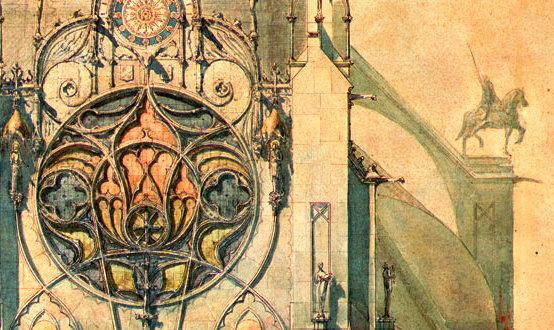
A Forgotten Architectural Fantasist
Wilhelm Cornelis Bauer of the Netherlands
Boullée isn’t the only architect known more for the designs never built than for those that were. Wilhelm Cornelis Bauer (1862–1904) was a Dutch architect with a flair for the fantastic. He was born into an aesthetically minded environment in the Hague, where his father ran an interior decoration firm; his brother, the painter and engraver Marius Bauer, is better known. W.C. Bauer (sometimes known as Willem) studied at the Craft School before heading to the Royal Academy of Visual Arts and became involved in the circle of Dutch architects that included Berlage, Walenkamp, Kromhout and others.
Bauer had a very high opinion of himself, being convinced of his own genius, which often brought him into conflict with others, including potential patrons. The buildings of his that were constructed (such as a handful of houses in Bussum) were within the reasonable bounds of the Dutch contemporary vernacular, but Bauer was an inveterate dreamer with elaborate visions. Architectural competitions proved a perpetual draw, and while Bauer’s designs were often commended as highly artistic they usual brought simultaneous comments about impracticability.
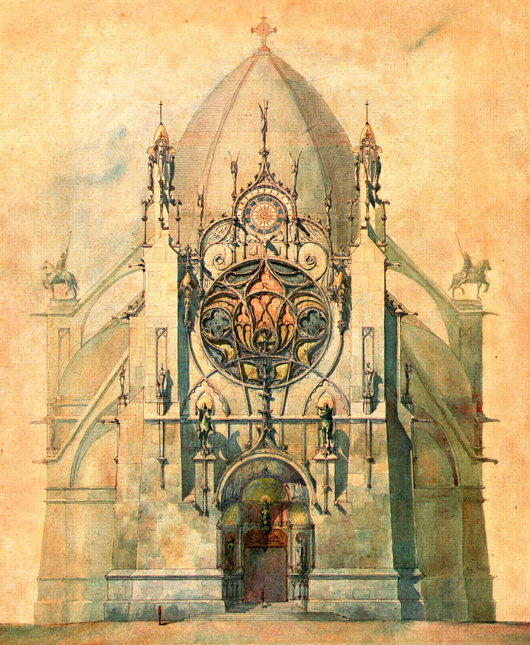
In an 1891 lecture to the ‘Architectura et Amicitia’ society in the Netherlands, W.C. Bauer argued that Eugène Viollet-le-Duc, the great French architect and theorist, never dreamed of the Gothic renaissance his work sparked but rather wished to show a foundation on which to build the future of architecture and the building arts. Bauer’s 1892 competition entry for a church (above) shows the architect’s intent to steer away from an academic revival of Gothic but instead to mould a building in a rather fantastic and free interpretation of the style.
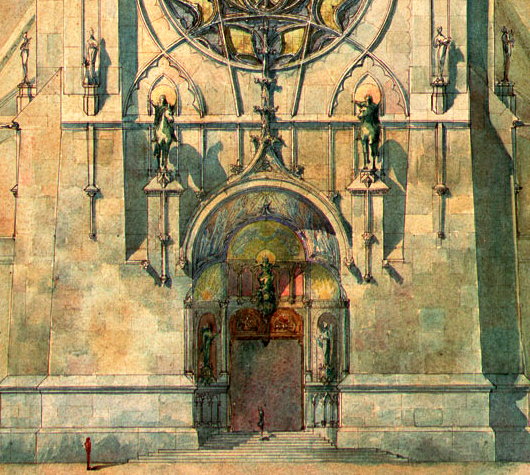
The entrance portal is a handsome composition, with tracery and sculpture ascending on either side to meet the bulk of the flanking buttresses. The polychromatic entryway contrasts well with the mostly blank stone surrounding it, and the use of a semicircular arch rather than a pointed one is an interesting and surprisingly successful choice.
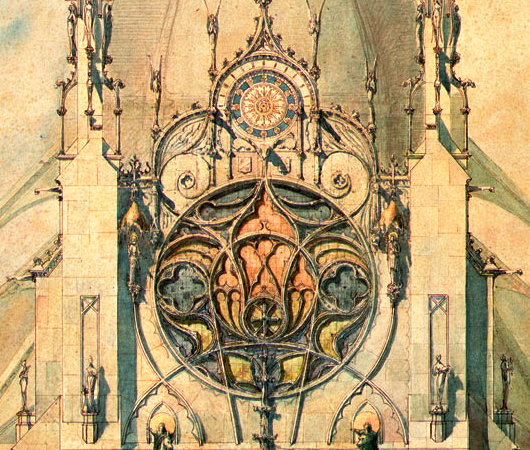
Moving upwards, we find an elaborate window of coloured glass surmounted by a rather handsome clock face. Bauer’s tracery manages to be free without being arbitrary, and the architect doesn’t overdo it: while we have fippery and detail in one place, he’s not afraid to contrast it with a framing of blank stone.
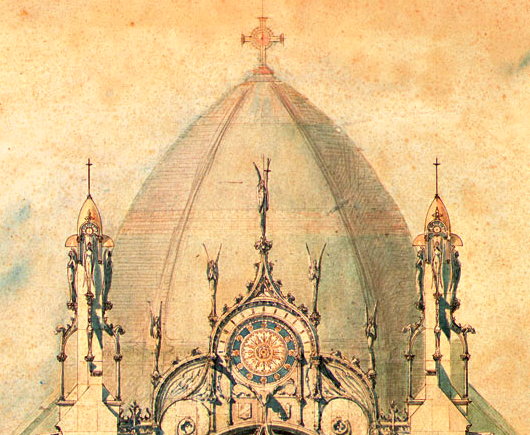
 Bauer’s dome is probably the weakest part of the design. It fits poorly with the rest of the composition, given the primarily Gothic influence. Had he elevated the dome on a fenestrated storey or even half-storey it would lend greater dignity as well as solve the problem of this design’s height, or lack thereof: there is a somewhat squat feeling to the church as viewed in Bauer’s rendering that some added verticality would solve easily. Overall, a poor composition with some fascinating components.
Bauer’s dome is probably the weakest part of the design. It fits poorly with the rest of the composition, given the primarily Gothic influence. Had he elevated the dome on a fenestrated storey or even half-storey it would lend greater dignity as well as solve the problem of this design’s height, or lack thereof: there is a somewhat squat feeling to the church as viewed in Bauer’s rendering that some added verticality would solve easily. Overall, a poor composition with some fascinating components.
None of Bauer’s more fantastic proposals, such as this, ever made it to the construction stage, probably thanks to the reluctance of the “genius” to compromise. He disliked playing second-fiddle as well, as evidenced by his turning down of Berlage’s offer to work on the design aspects of the Stock Exchange, one of the most significant architectural works in the late nineteenth century Netherlands. His politics were equally erratic — Bauer considered himself something of an anarchist and admired Thoreau — and his soundness of mind varied. Suffering from paralysis and syphilitic depression, Wilhelm Cornelis Bauer killed himself in 1904, and has remained mostly forgotten since then.
Search
Instagram: @andcusack
Click here for my Instagram photos.Most Recent Posts
- Articles of Note: 11 November 2024 November 11, 2024
- Why do you read? November 5, 2024
- India November 4, 2024
- The Lithe Efficiency of the Old Constitution November 4, 2024
- Waarburg October 2, 2024
Most Recent Comments
Book Wishlist
Monthly Archives
Categories



I dislike it. I really don’t mind it’s parts, but overall it just looks [i]bad[/i].
Gaudí was also a Gothic Revival fantasist whose work was not limited to the drawing board.
One might also argue that Viollet-le-Duc himself was a fantasist in that his restorations were openly an idealized view of what should have been, not necessarily a restoration of what existed at a single moment in time.
Not forgotten in Hungary (but little known outside), is a contemporary of Bauer, the Hungarian architect Odon Lechner.
http://hu.wikipedia.org/wiki/Lechner_%C3%96d%C3%B6n#Alkot.C3.A1sai
P. J. Szule, Manhattan
I would not like to create a kind of a link-festival, but speaking about architectural fantasies (with Gaudí and Lechner in the background) reminds me another quite forgotten architect, also a contemporary of Bauer: Władysław Horodecki and his own house, so called ‘House with Chimæras’.
http://en.wikipedia.org/wiki/House_with_Chimaeras